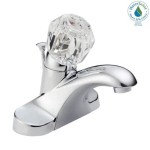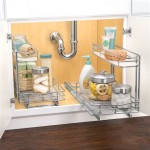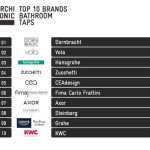What Is A Good Flow Rate For A Bathroom Faucet?
Determining a good flow rate for a bathroom faucet involves understanding water efficiency standards, typical usage scenarios, and personal preferences. Flow rate, measured in gallons per minute (GPM), indicates the volume of water a faucet dispenses. A well-chosen flow rate balances water conservation with adequate performance for various bathroom tasks. Several factors contribute to the ideal flow rate, making it a multifaceted consideration for homeowners and builders.
The primary impetus for considering flow rate is water conservation. Water is a finite resource, and reducing consumption has both environmental and financial benefits. Lower flow rates translate to decreased water bills and contribute to sustainable living practices. However, a flow rate that is too low may render the faucet ineffective for certain tasks, leading to frustration and potentially longer usage times, which can negate the intended water savings.
Regulatory standards play a significant role in shaping acceptable flow rates. These standards are designed to promote water efficiency across a range of plumbing fixtures. By examining these standards and understanding how they apply to bathroom faucets, individuals can make informed decisions about the flow rate that best suits their needs and aligns with water conservation principles.
The size of the sink and its intended use also impacts the decision. A smaller sink, such as one found in a powder room, might not require as high a flow rate as a larger sink used for more extensive washing. Similarly, the frequency of use affects the overall water consumption, making flow rate an important consideration for high-traffic bathrooms.
Furthermore, aesthetic considerations, such as the type of faucet design, can influence the perceived effectiveness of a particular flow rate. Some faucet designs, particularly those with aerators, can create a satisfying water stream even with a lower flow rate. Understanding these nuances is crucial for selecting a faucet that provides both functionality and water efficiency.
Ultimately, a good flow rate for a bathroom faucet is a balance between conserving water, meeting regulatory requirements, and providing adequate performance for the intended use. By carefully considering these factors, consumers can choose a faucet that optimizes water usage and delivers a satisfactory user experience.
Understanding Standard Flow Rates and Regulatory Compliance
The United States Environmental Protection Agency (EPA) plays a crucial role in establishing water efficiency standards through its WaterSense program. WaterSense-labeled bathroom faucets are certified to meet specific performance criteria, including a maximum flow rate of 1.5 GPM. This standard is significantly lower than the previously common flow rate of 2.2 GPM, representing a substantial reduction in water consumption. WaterSense certification ensures that faucets meet both water efficiency and performance requirements.
The 1.5 GPM standard applies to most standard bathroom faucets intended for residential use. This rate provides sufficient water pressure for handwashing, face washing, and other common bathroom tasks while minimizing water waste. Manufacturers must comply with this standard to earn the WaterSense label, which is a valuable indicator for consumers seeking water-efficient products.
Some jurisdictions may have stricter regulations than the federal WaterSense standard. State and local building codes may further limit the allowable flow rate for bathroom faucets. It is essential to check local regulations to ensure compliance when selecting a new faucet. These stricter codes often reflect a greater emphasis on water conservation in regions with limited water resources or a strong commitment to environmental sustainability.
Non-compliance with these regulations can result in fines or the rejection of building permits. Therefore, builders and homeowners alike must be aware of the applicable standards and choose faucets that meet or exceed these requirements. Adherence to WaterSense guidelines and local regulations not only ensures compliance but also contributes to responsible water management practices.
It's also worth noting that some specialty faucets, such as those designed for commercial use or specific medical applications, may have different flow rate standards. These exemptions are generally based on the unique requirements of the intended application. However, for typical residential bathroom faucets, the 1.5 GPM WaterSense standard is a widely accepted and regulated benchmark.
Choosing WaterSense-labeled faucets provides assurance that the product has been independently tested and certified to meet water efficiency standards. This certification eliminates guesswork and simplifies the process of selecting a water-saving faucet while maintaining a satisfactory user experience.
Factors Influencing Perceived Flow Rate
While the actual flow rate of a bathroom faucet is a quantifiable measurement, the *perceived* flow rate can be influenced by several factors, including faucet design, aerator technology, and water pressure. Understanding these elements can help consumers choose a faucet that feels adequate even with a lower flow rate.
Faucet design plays a significant role in how the water is delivered. A narrow spout, for example, might create a more concentrated stream of water, making it feel more forceful even if the actual flow rate is lower. Conversely, a wide, open spout might disperse the water, making it feel less powerful. The shape and angle of the spout also contribute to the overall user experience.
Aerators are devices installed at the tip of the faucet that mix air with the water stream. This process creates a bubbly, voluminous flow that can feel more substantial than a non-aerated stream, even at the same flow rate. Aerators are a common feature in water-efficient faucets because they enhance the perceived water pressure while reducing actual water consumption. The type of aerator used, such as laminar flow or spray aerators, affects the texture and appearance of the water stream.
Water pressure within the plumbing system also influences the perceived and actual flow rate. Low water pressure can diminish the effectiveness of even a 1.5 GPM faucet, making the stream feel weak and inadequate. Conversely, high water pressure can make a faucet feel more powerful, even if its actual flow rate is relatively low. It is important to ensure that the plumbing system provides adequate water pressure to maximize the performance of water-efficient faucets.
The type of sink bowl also plays a role. A deeper sink bowl might require a slightly higher perceived flow rate to ensure adequate rinsing and cleaning. A shallow sink bowl, on the other hand, might be perfectly adequate with a lower flow rate. The size and shape of the sink should be considered in conjunction with the faucet’s flow rate and design.
Color and lighting in the bathroom can also subconsciously affect perception. A brighter, well-lit bathroom might make the water appear clearer and more appealing, leading to a more positive user experience. Conversely, a dimly lit bathroom might make a lower flow rate feel less satisfying.
Ultimately, the perceived flow rate is a subjective experience influenced by a combination of physical and environmental factors. By considering these elements, consumers can choose a faucet that not only meets water efficiency standards but also provides a satisfying and functional user experience.
Matching Flow Rate to Specific Needs and Usage
The ideal flow rate for a bathroom faucet is not a one-size-fits-all answer. It depends on the specific needs and usage patterns of the individuals using the faucet. Bathrooms used primarily for quick handwashing may require a lower flow rate than those used for more extensive tasks, such as shaving or face washing.
For powder rooms or guest bathrooms, where the faucet is mainly used for handwashing, a flow rate closer to the minimum allowed by WaterSense (1.5 GPM) might be perfectly adequate. These bathrooms typically experience less frequent and less demanding water usage, making water conservation a primary consideration.
In master bathrooms or bathrooms used by multiple family members, a slightly higher perceived flow rate might be preferred to accommodate a wider range of tasks. While adhering to the 1.5 GPM standard, choosing a faucet with an aerator or a specific spout design can enhance the perceived water pressure and improve overall satisfaction.
Considerations should also be given to individuals with specific needs, such as children or elderly family members. Faucets designed with easy-to-use handles and consistent water pressure are essential for these populations. Adjustable flow rate settings can also be beneficial, allowing users to customize the water pressure to their individual preferences.
For households with a strong emphasis on water conservation, low-flow faucets with flow rates lower than 1.5 GPM are available. These faucets often incorporate advanced aerator technology to maintain adequate perceived pressure while further reducing water consumption. However, it is important to ensure that these faucets still meet the minimum requirements for effective handwashing and other essential tasks.
The number of people using the bathroom also influences flow rate considerations. In households with multiple occupants, the cumulative water savings from a lower flow rate can be significant. Choosing water-efficient faucets throughout the home can contribute to substantial reductions in overall water consumption.
Ultimately, selecting the right flow rate involves a careful assessment of individual needs, usage patterns, and water conservation goals. By considering these factors, consumers can choose a bathroom faucet that balances efficiency, performance, and user satisfaction.

What Is The Average Flow Rate Of A Kitchen Or Bathtub Faucet

A Guide To Water Flow Rates Qualitybath Com Discover
The Perfect Shower Head Water Flow Bathselect Blog

What S A Good Water Flow Rate For Kitchen Faucet

Understanding Shower Flow Rates Delta Faucet Inspired Living

Faucet Flow Rates Viga Manufacturer

What S A Good Water Flow Rate For Kitchen Faucet

Low Flow Fixtures Bathroom Kitchen Faucets Building Science Education

5 Things To Know About Low Flow Faucets And Fixtures Bob Vila

Bathroom Faucets Us Epa
Related Posts







